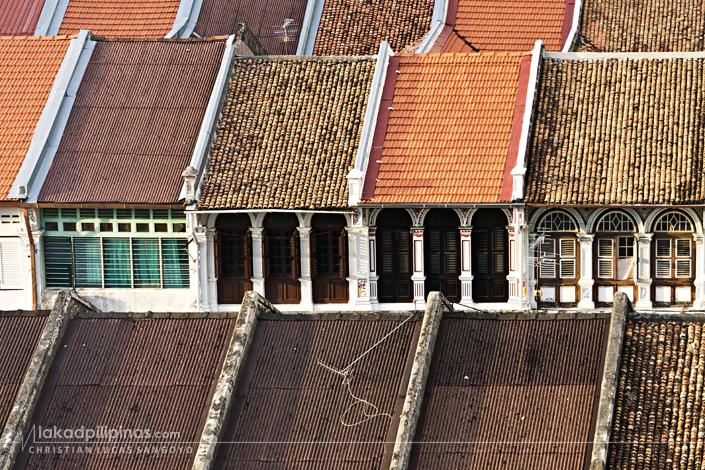George Town is Penang’s main tourist draw. Its city center is a UNESCO World Heritage Site—with its charming, old-world shophouses and handsome colonial structures. Its popularity with tourists skyrocketed in 2012 when street art and wall murals started appearing along its age-old walls.
UNDERSTAND CENTRAL GEORGE TOWN
 |
| A TYPICAL STREET AT GEORGE TOWN’S HISTORIC CENTER IN PENANG |
George Town, which is almost always incorrectly spelled as Georgetown, is a city that encompasses the whole of Penang Island. Its center is Central George Town, which is subdivided into the Core Zone Historic Center, Buffer Zone Historic Center, Central Business District, and outer George Town.
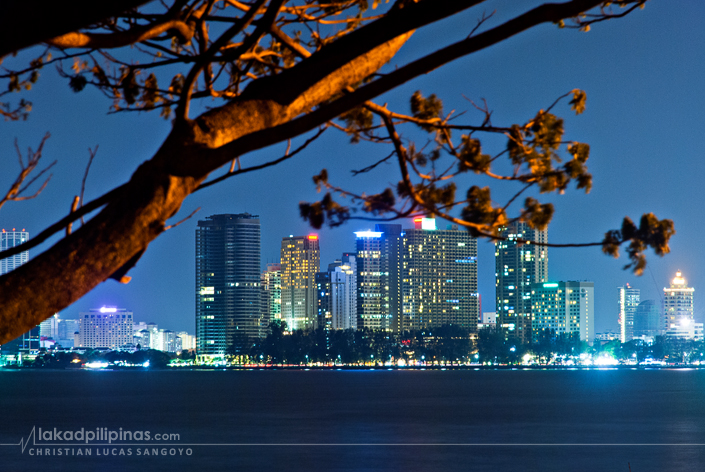 |
| CENTRAL GEORGE TOWN’S CBD AREA |
The UNESCO World Heritage part of George Town is actually only a seventh in size with that of Central George Town’s 19-hectare area. Located on the easternmost side of town, these are the Core Zone and Buffer Zone. Most of George Town’s tourist spots are located within this historic center, but there’s still a lot to see outside these two areas.
HOW TO GET TO CENTRAL GEORGE TOWN
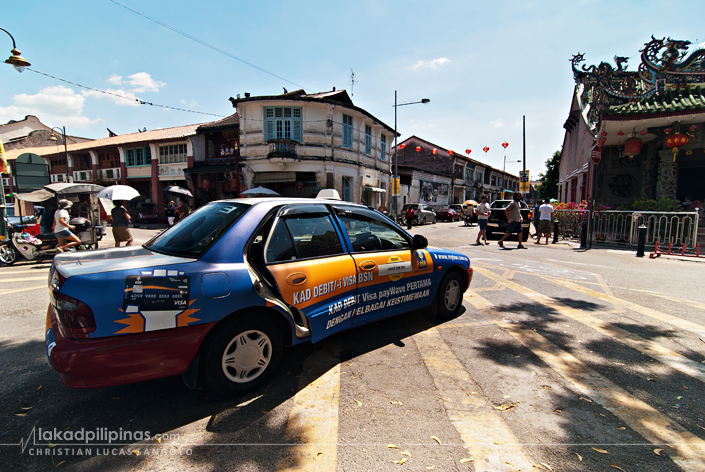 |
| GETTING AROUND GEORGE TOWN |
Rapid Penang buses goes to and from Central George Town with terminus at Komtar Bus Terminal and the Weld Quay Jetty Bus Terminal. There are also free CAT (Central Area Transit) Buses that loops around George Town’s historic core. Taxis and Grab Cars are also available in the city, so are colorful trishaws that you can rent for quick tours around the historic core.
CENTRAL GEORGE TOWN STREET ART
George Town is famous for its street art, and it’s actually one of its main driving force. A lot of tourists go to Penang to simply pose beside these wall murals. One unique aspect of George Town street art is how it integrates real-world objects with painted ones.
ERNEST ZACHAREVIC
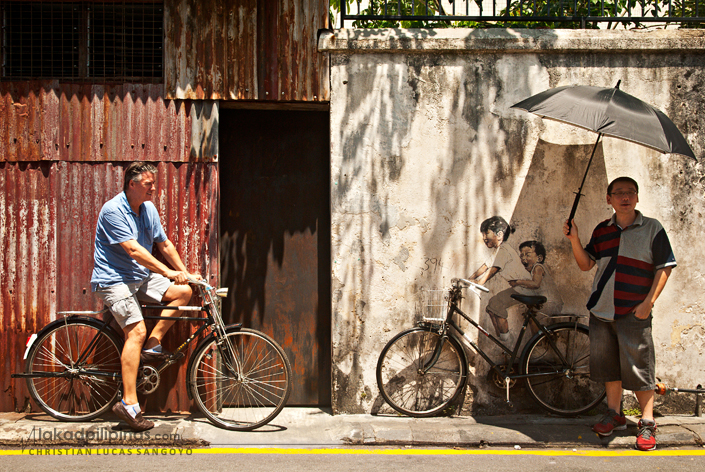 |
| ERNEST ZACHAREVIC’S CHILDREN ON A BICYCLE, A PENANG FAVORITE FOR TOURISTS |
It was in 2012 when Lithuanian artist Ernest Zacharevic did Mirrors of George Town for the George Town Festival—six murals painted over parts of George Town that put Penang on the world’s tourist map. These include the now iconic Little Children on a Bicycle (Armenian Street), The Boy and his Motorbike and Little Boy with a Pet Dinosaur (Ah Quee Street), and Boy on a Chair (Cannon Street).
LOUIS GAN
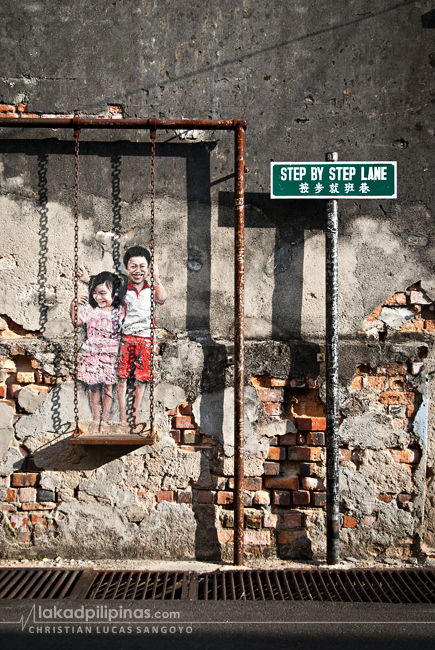 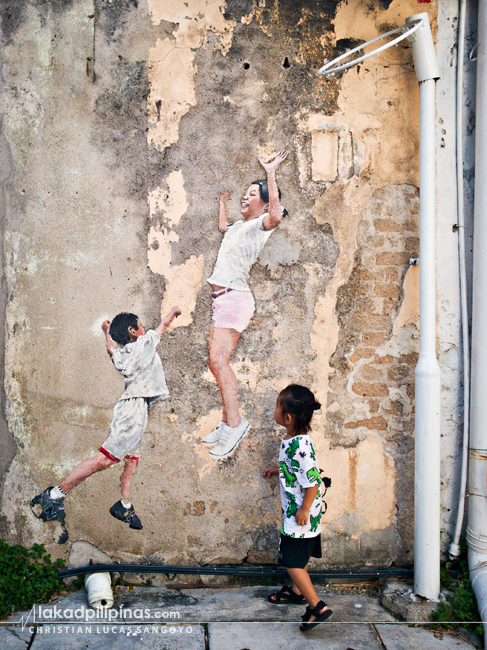 |
| LOUIS GAN’S BROTHER & SISTER ON A SWING AND CHILDREN PLAYING BASKETBALL |
A few of the more famous murals in Penang is the work of a deaf-mute Penangite, Louis Gan. A few of these are Brother and Sister on a Swing (Step By Step Lane), Children Playing Basketball (Chulia Street), and Nostalgic Meal Order (Kinta Alley). These works are within the Penang street art framework of mixing real-world objects with art.
JULIA VOLCHKOVA
  |
| JULIA VOLCHKOVA’S THE INDIAN BOATMAN & OLD INDIAN WOMAN ~ PHOTO BY AH WEI FROM FLICKR |
Another prominent artist that has made it mark in Penang is Julia Volchkova. The Russian artist has done evocative portraits of Indian people. A few of her notable works in Central George Town are the Old Indian Woman (Lumut Lane), Indian Water Bearer (Acheh Street), and The Indian Boatman (Stewart Lane). A few of her larger-than-life work, standing two-storeys high, can also be seen at Balik Pulau—which is not part of Central George Town, by the way—are The Old Fisherman, The Silat Master, and The Rubber Tapper.
101 LOST KITTENS
 |
| ONE OF THE ORIGINAL TWELVE 101 LOST KITTENS |
Painted by the group Artists for Stray Animals are a series of twelve cat-inspired street art and murals along the streets of Central George Town to raise awareness about the strays in the city. Some of the more famous of these are The Real Bruce Lee Would Never Do This (Ah Quee Street), Cats Walking for Animal Awareness (Beach Street), and I Can Help Catch Rats (Armenian Street).
PENANG IRON ROD STREET ART
 |
| ONE OF THE 52 QUIRKY IRON ROD STREET ART IN CENTRAL GEORGE TOWN |
Spread out all along George Town are 52 metal rod artworks depicting funny local scenes in the city. The rods are bent and curved to create outlines, ala comic caricature-style, and are created by KL-based art studio, Sculpture At Work in 2013.
CLAN JETTIES OF PENANG
Located on the eastern part of the George Town historic center, along Weld Quay, are six jetties made famous by houses on stilts that stand beside its wooden walkways. Pengkalan Weld was part of a reclaimed area in the late 19th century and the jetties that jutted out of it were the product of Chinese workers employed along the harbor. Each floating village were named after the clans that occupy it.
YEOH JETTY
 |
| YEOH JETTY ~ PHOTO FROM GOOGLE MAPS |
The southernmost jetty from the bunch. Like most of the clan jetties, Yeoh Jetty is built during the late nineteenth century. Its structures are situated on the shallower portion of the sea and the pylons that support the houses can actually be seen standing on mudflats as the tide ebbs.
NEW JETTY
 |
| A VIEW OF NEW JETTY FROM CHEW JETTY |
As with the name, this is the newest of the six jetties. Built during the sixties, it is also the smallest—sheltering only twenty two houses. It is also called the Mixed Clan Jetty, since the residents here are, well, composed of mixed clans.
LEE JETTY
 |
| LEE JETTY ~ PHOTO FROM GOOGLE MAPS |
Built by laborers from China’s Fujian Province, Lee Jetty is the shortest of the six. This is one of the least commercial of the jetties and is best visited during the evenings, with its plethora of colorful lights and lanterns lighting the pier.
TAN JETTY
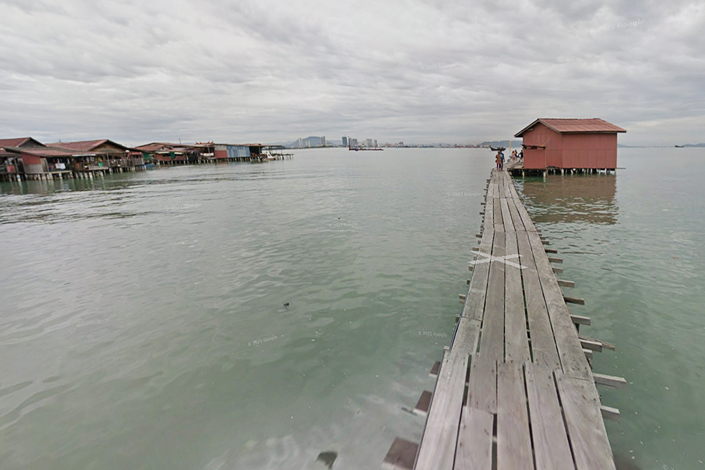 |
| TAN JETTY’S MAZU TEMPLE ~ PHOTO FROM GOOGLE MAPS |
The Tan Jetty is unique to the other six as it is home to Chinese fishermen rather than descendants from coolies or laborers from yesteryears. It is also the longest of the six, with a railless wooden pier extending seaward and ending on a nondescript red temple for Mazu, the Goddess of Seafarers.
CHEW JETTY
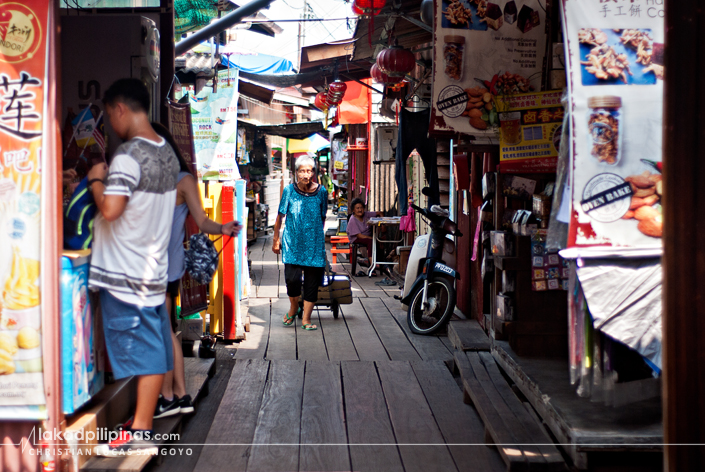 |
| CHEW JETTY’S BUSY WALKWAY |
The oldest, most populated, and most popular of the six jetties, Chew Jetty is as commercial as it can get. Most of the residences that front its wooden path are now converted into shops, restaurants, and even lodgings for tourists. There are also a bit of street art that can be found on a few of the sea-worn wooden walls of its stilt houses.
LIM JETTY
 |
| LIM JETTY, QUIET BUT STILL INTERESTING |
Rebuilt after being destroyed during the Second World War, Lim Jetty is the northernmost of the six Penang jetties. The families residing here migrated from China’s Hokkien Province during the early 1900s. Its structures are composed mainly of residences, without shops and restaurants for tourists, but no less interesting.
CENTRAL GEORGE TOWN MUSEUMS
Penang has tons of museums catering to all walks of life—for kids to adults, from art to whimsical, food to religion, and random stuff, like, ghosts. According to Google Maps, Central George Town has no less than twenty museums to date. And for brevity, let’s just list the five most interesting museums in Central George Town.
BATIK PAINTING MUSEUM PENANG
 |
| BATIK PAINTING MUSEUM ~ PHOTO FROM GOOGLE MAPS |
Housed inside an eclectic Straits Settlement-style shophouse, the three-story Muzium Lukisan Batik Pulau Pinang holds no less than eighty batik paintings done by twenty five Malaysian artists. Perfect for people who are into unique local art.
PINANG PERANAKAN MANSION
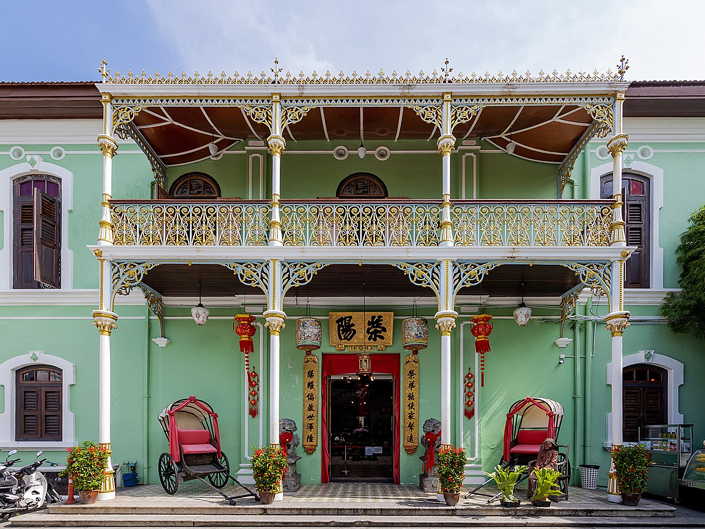 |
| PENANG PERANAKAN MANSION ~ PHOTO BY SUPANUT ARUNOPRAYOTE FROM WIKIMEDIA COMMONS |
Peranakans generally refer to people with mixed Chinese and Malay blood. And the grand fusion of these cultures can be seen on the numerous artifacts and the interiors of the Pinang Peranakan Mansion.
For a deeper understanding of Peranakan Culture, a visit to the Pinang Peranakan Mansion is a must. And since the museum was also featured as one of the Pit Stops for the sixteenth season of The Amazing Race, it’s also a must-visit for The Amazing Race fans as well.
ASIA CAMERA MUSEUM
 |
| THE ASIA CAMERA MUSEUM |
The Asia Camera Museum is divided into three sections—the Dark Room, where you can explore how to actually develop a picture from film; the Camera Repair Workplace, where you can get your hands on tools used to repair cameras in the sixties; and finally the Camera Collection, where you can actually hold hundreds of antique and vintage cameras and equipment. There aren’t many museums dedicated to cameras, so a visit is a must for photography enthusiasts.
WONDER FOOD MUSEUM
 |
| LARGER THAN LIFE FOOD AT WONDER FOOD MUSEUM PENANG ~ PHOTO FROM THEIR FB PAGE |
Penang, being one of Malaysia’s culinary centers, of course has a museum dedicated to food. If you haven’t had enough of eating around Penang, then delve into a playful world of food at the Wonder Food Museum. Here, oversized Malaysian dishes are displayed, ready for you and the ‘gram. But if you’re not into that, there are also more serious sections in the museum which explore about the history and heritage of Malaysian cuisine.
PENANG STATE MUSEUM AND ART GALLERY
 |
| PENANG STATE MUSEUM & ART GALLERY ~ PHOTO FROM THEIR WEBSITE |
Housed in a Malaysian heritage building, the Penang State Museum and Art Gallery has an impressive collection of modern and contemporary Malaysian art—from paintings, sculptures, photographs, and even video films and old maps. It also has a rotating gallery that features both local and international artists. For art enthusiasts, this is the museum to visit in Penang.
CENTRAL GEORGE TOWN TEMPLES & MOSQUES
Central George Town is home to numerous temples. Malaysia’s multi-cultural facet is also reflected with the town’s diverse house of worships—from Muslim mosques, Burmese temple, Thai wats, Christian churches, and Hindu mandirs. There are probably a hundred worship places in Penang, and listed here are a few of the most interesting ones. Note that Ke Klok Si, the largest Buddhist temple in Malaysia, isn’t listed here as it’s really not located in Central George Town.
KAPITAN KELING MOSQUE
 |
| KAPITAN KELING MOSQUE IN GEORGE TOWN |
Arguably the most popular mosque in Penang, Masjid Kapitan Keling is a 19th century Indian Muslim mosque. It is the biggest mosque in Penang and sports an Indian-Moghal architecture. It features a huge central dome offset by two smaller ochre ones. A separate minaret stands independently off its left flank.
LEONG SAN TONG KHOO KONGSI TEMPLE
 |
| ORNAMENTATION OVERLOAD AT THE KHOO KONGSI TEMPLE |
The most ornate temple this side of Malaysia, the Leong San Tong Khoo Kongsi Temple—or simply Khoo Kongsi Temple—is actually part of a Hokkien clanhouse clustered around a granite-paved square. It was built in 1906 for the Khoos—a wealthy Chinese clan in Penang.
PENANG SNAKE TEMPLE
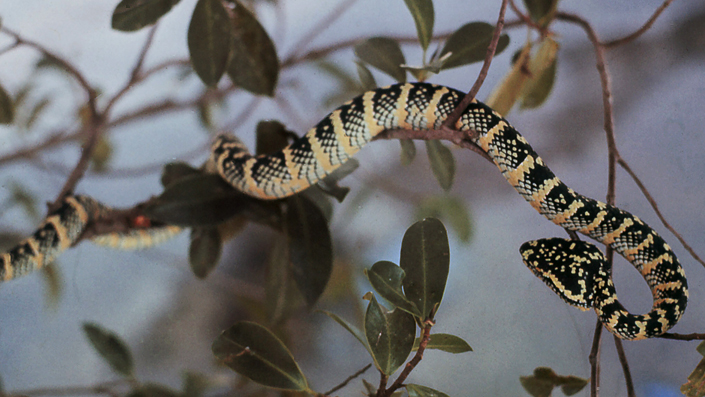 |
| AN ACTUAL SNAKE AT PENANG’S SNAKE TEMPLE ~ PHOTO BY WILFORD PELOQUIN FROM WIKIMEDIA COMMONS |
Also known as Temple of the Azure Clouds, Penang’s Snake Temple indeed has live snakes inside its halls, which the faithful believes to be the reincarnation of Master Qingshui’s disciples. It was constructed in 1805 and is home to numerous de-venomed pit vipers, among other snakes.
WAT CHAYAMANGKALARAM
 |
| THE RECLINING BUDDHA AT WAT CHAYAMANGKALARAM IN GEORGE TOWN |
The Chayamangkalaram Temple is a Theravada Buddhist temple built for the Thai community during the 1800s. It features one of the world’s longest reclining Buddha. Like most wats in Thailand, they also celebrate the festive Songkran Water Festival around this area.
DHAMMIKARAMA BURMESE TEMPLE
 |
| GIANT STANDING BUDDHA AT PENANG’S ONLY BURMESE TEMPLE |
Right across the Thai temple is the Dhammikarama Burmese Temple. It’s also a Theravada Buddhist temple, but it is the only Burmese temple in the whole of Penang. Built in 1803, it features a traditional Burmese stupa and a huge Standing Buddha. The temple also celebrate the Thingyan Festival, a similar water festival that almost coincides with its neighbor’s Songkran Festival.
ARULMIGU BALATHANDAYUTHAPANI TEMPLE
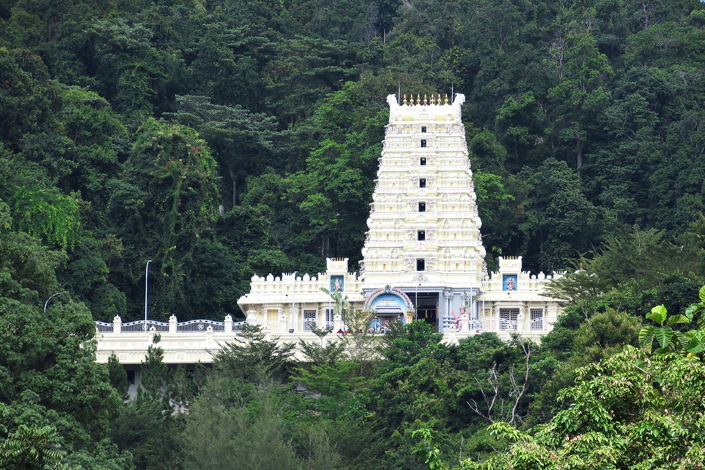 |
| THE HINDU WATERFALL HILLTOP TEMPLE ~ PHOTO FROM THEIR FB PAGE |
Popularly known as the Waterfall Hilltop Temple, the Balathandayuthapani Temple is a Hindu mandir built on a hill top near the Penang Botanical Garden. With its seven-storey high gopuram tower, it is the largest Lord Mururgan temple outside of India.
PENANG OLD PROTESTANT CEMETERY
 |
| PENANG’S OLD PROTESTANT CEMETERY |
While not really a place of worship, the old Protestant Cemetery is an interesting and beautiful—in a somber way—place to visit when in Central George Town. Also known as Northam Road Cemetery, it was established in 1786 and is a historic disused Protestant graveyard filled with ornate tombs and statues surrounded by a grove of fragrant frangipani trees.
CENTRAL GEORGE TOWN HISTORIC BUILDINGS
With Penang’s colonial past, Central George Town is replete with stately government buildings. And even though the island has been bombed and strafed by the Japanese Imperial Forces during the Second World War, a few historic structures still remain intact.
MALAYAN RAILWAY BUILDING & CLOCK TOWER
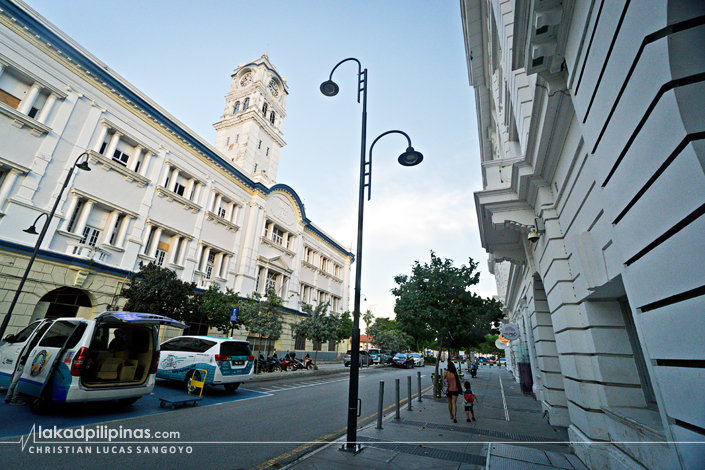 |
| GEORGE TOWN’S MALAYAN RAILWAY BUILDING & CLOCK TOWER |
One of the most imposing colonial era building in the whole of Penang, the Malayan Railway Building served as a railway ticketing station for people traveling via the Prai Railway Station. It is interesting to note that back then, people need to purchase their tickets here before taking a boat to the mainland, where the actual railway station is. Built in 1909, the Edwardian Baroque-style station is 73 meters long with a 45 meters tall clock tower with a massive two-ton bell.
PENANG CENTRAL FIRE STATION
 |
| PENANG CENTRAL FIRE STATION’S RED AND WHITE FACADE |
Also built in 1909 is Penang’s first Central Fire Station. It’s a four-storey building painted in immaculate white with red highlights. It has a Classical cum Edwardian cum Mughal architectural style. Its ground floor has a mini museum open for visitors, and an actual fire truck where you can sit in.
PENANG CITY HALL & TOWN HALL
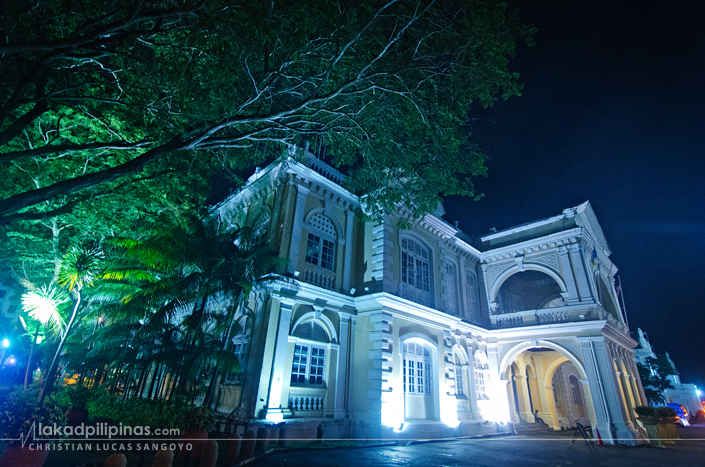 |
| EVENING VIEW OF THE PENANG TOWN HALL |
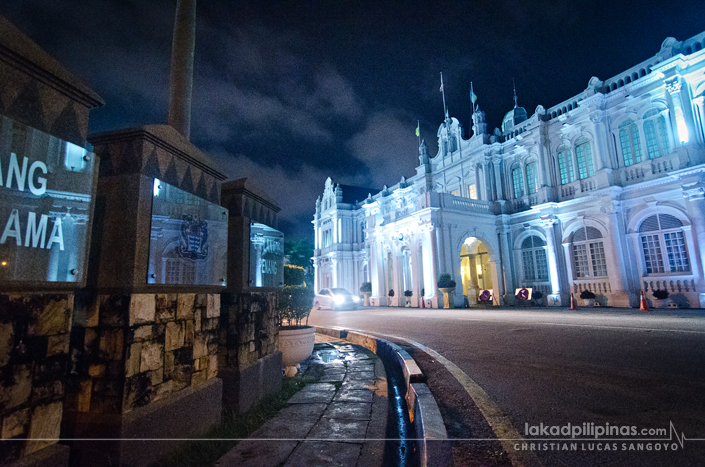 |
| THE LIGHTED FACADE OF PENANG CITY HALL |
Located right next to each other are two of the most beautiful buildings in Penang, the Penang Town Hall and Penang City Hall. The Town Hall was constructed in 1880 while the City Hall followed 23 years later. Both have ornate Palladian and Edwardian Baroque façade.
FORT CORNWALLIS
 |
| FORT CORNWALLIS ENTRANCE ARCH |
Penang’s Fort Cornwallis was built in 1786 when the British took Penang from the Sultan of Kedah. Its present form of brick and stone was finished in 1810. There are numerous cannons inside the fort as well as a 21-meter lighthouse—the second oldest in Malaysia.
QUEEN VICTORIA MEMORIAL CLOCK TOWER
 |
| QUEEN VICTORIA MEMORIAL CLOCK FROM THE ROTUNDA |
Also known as the Jubilee Clock Tower, the beautiful Moorish-style thirty-meter tall clock tower was built to commemorate the Diamond Jubilee of Queen Victoria in 1897.
CENTRAL GEORGE TOWN PARKS
George Town is located in between mountains on the west and the sea on the east. And in these are sprawling mountain parks, small urban pocket parks surrounded by colonial houses, and seaside promenades. One of the most popular parks in George Town is Penang Hill, this however, falls outside of Central George Town.
PENANG BOTANIC GARDENS
 |
| PENANG BOTANIC GARDENS ~ PHOTO BY DR. HTGOON FROM WIKIMEDIA COMMONS |
Established in 1884 from an old granite quarry by the same guy that supervised the Singapore Botanic Gardens, the Penang Botanic Gardens is located on the northern outer area of Central George Town. The 29 hectare garden is a popular spot for walking, jogging, and trekking. There’s also a 121-meter waterfall in the area, but it can only be accessed during organized guided tours.
PENANG CITY PARK
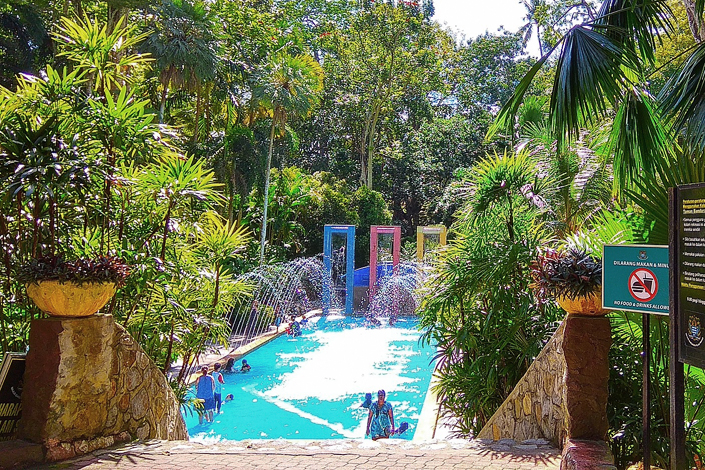 |
| PENANG CITY PARK’S PUBLIC POOL ~ PHOTO BY VNONYMOUS FROM WIKIMEDIA COMMONS |
Located near the foot of the Penang Botanic Gardens, the City Park is a Youth Park. Opened in 1972, it has playgrounds, skating rink, outdoor auditorium, graffiti walls, nature trails, reflexology paths, and even a public swimming pool.
COLOR PORT
 |
| THE COLORFUL COLOR PORT IN GEORGE TOWN |
Situated along Weld Quay is a colorful seaside promenade dubbed as the COLOR PORT. True to its name, it is indeed a colorful park designed to appeal to younger people. Besides playgrounds for kids, it has numerous food stalls, café, and shopping kiosks.
MBPP WALKWAYS
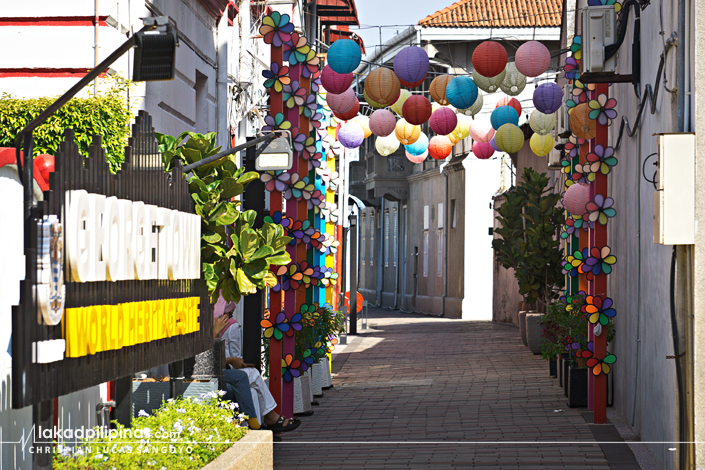 |
| ONE OF THE MBPP WALKWAYS IN GEORGE TOWN |
A project of Penang Island City Council, the MBPP Walkways are city alleys converted into bright and colorful linear parks in George Town. These areas are usually characterized with colorful paving blocks, poles, overhead umbrellas, and bright lamps.
KOMTAR THE TOP PENANG THEME PARK, RAINBOW SKYWALK, THE GRAVITYZ
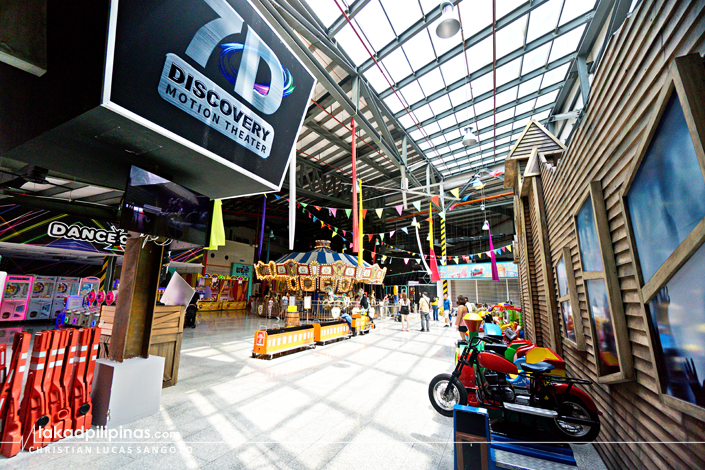 |
| THE TOP THEME PARK AT THE UPPER FLOORS OF KOMTAR PENANG |
Located at Komtar Tower, THE TOP is an indoor kiddie theme park located at the upper floors of Penang’s transport hub. It has numerous rides, arcade machines, dinosaur park, carousels, 7D theater, and restaurants.
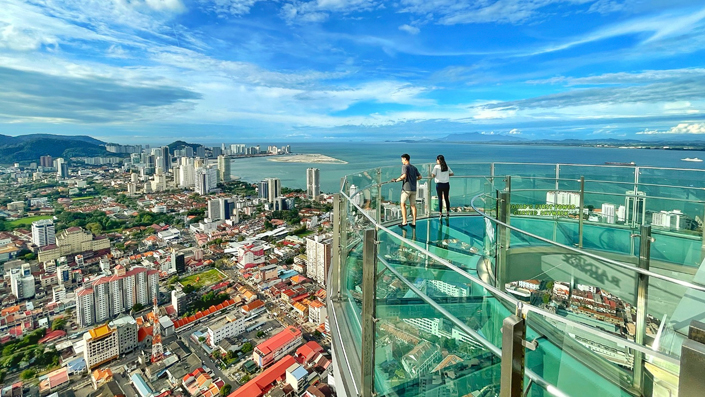 |
| PENANG RAINBOW SKYWALK ~ PHOTO FROM THEIR FB PAGE |
It also houses the Penang Rainbow Skywalk. At 248 meters high, it is the highest outdoor glass sky walk in Malaysia. The 16-meter U-shaped walkway looks over Central George Town, all the way to Tangjung Tokong, Pulau Tikus, Air Itam, and Penang Hill.
 |
| THE GRAVITYZ ~ PHOTO FROM THEIR WEBSITE |
There is no bungee jumping at Penang’s Rainbow Skywalk, but The Gravityz at Level 65, does offer a one-hour rope course challenge, elevated 239 meters above ground.
FAMOUS CENTRAL GEORGE TOWN STREETS
The whole George Town Historic Zone is famous, but some of its streets and thoroughfares are more famous than others. Here are a few of the notable ones.
LEBUH KING ~ LITTLE INDIA
 |
| A STREET FOOD HAWKER IN LITTLE INDIA |
Part of Penang’s Indian enclave, Lebuh King is replete with colors from Indian stores selling scarves and clothes, distinct Indian music, the scent of numerous spices, and of course, delicious Indian cuisine.
LEBUH ARMENIAN
 |
| TYPICAL VIEW AT LEBUH ARMENIAN |
Famous for Ernest Zacharevic’s iconic Little Children on a Bicycle, Lebuh Armenian is one of the most popular streets in Penang. It’s home to ornate clan houses, colorful shophouses, restaurants, cafés, and museums.
LOVE LANE
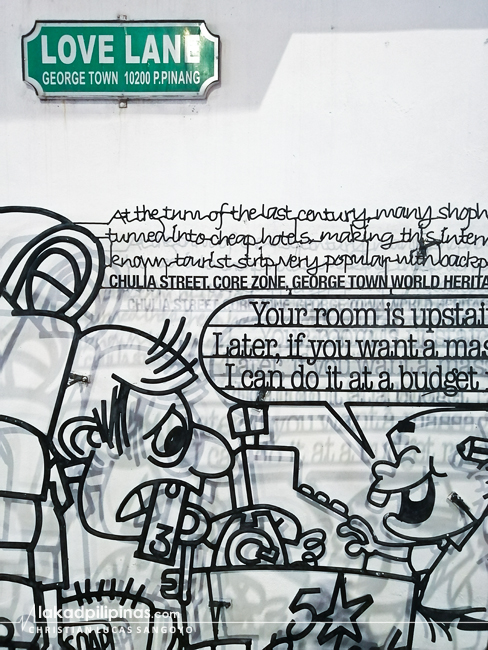 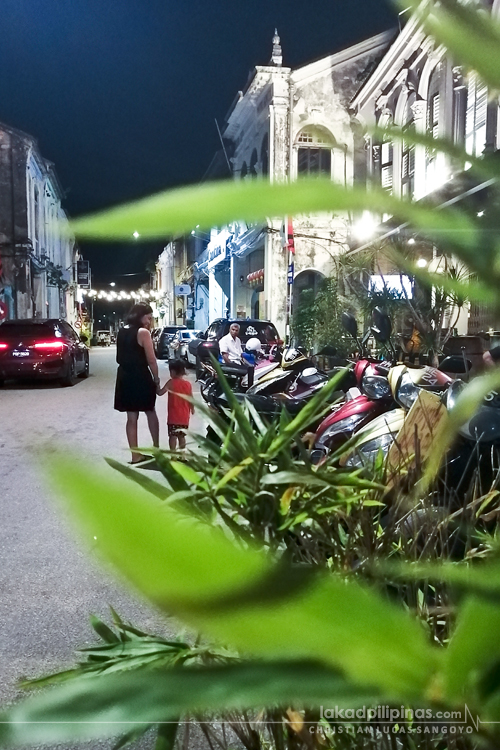 |
| LOVE LANE BACKPACKER AREA |
The center numerous budget hostels in Penang, Love Lane is George Town’s backpacker area. Its corner at Lebuh Chulia transforms into a party street at night as bar crowds spill right into the road. The streets moniker came from its past as an area for brothels where rich locals keep their mistresses.
LEBUH CHULIA
  |
| FOOD PLACES IN LEBUH CHULIA |
Opened in 1798, Lebu Chulia is one of the oldest roads in George Town. It is a haven for foodies with its multitudes of restaurants, bars, and hawker stalls that come alive during the evenings.
JALAN KEK CHUAN
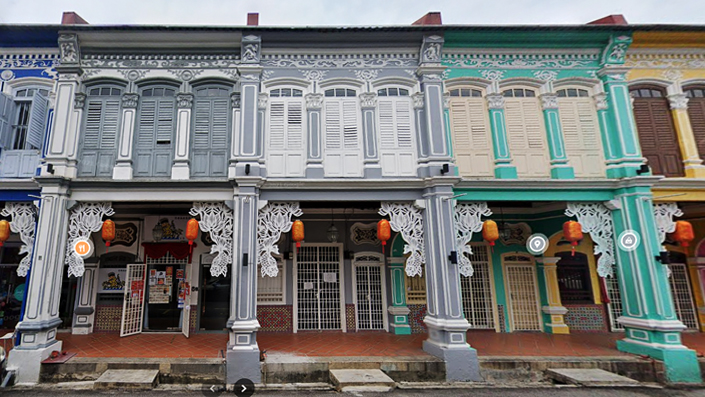 |
| COLORFUL SHOPHOUSES IN JALAN KEK CHUAN ~ PHOTO FROM GOOGLE MAPS |
Named as one of the forty of the Most Beautiful Streets in the World That Will Stop You in Your Tracks by House Beautiful, Jalan Kek Chuan is host to colorful rows of shophouses sporting a uniform architectural design painted with the colors of the rainbow. The view is particularly beautiful and hypnotic along its sidewalk arcade.
CENTRAL GEORGE TOWN FOOD STREETS
Evenings are special in Penang—select streets are closed to motorized traffic, hawker stalls start to open shop, and the aroma and smoke from various street foods starts to waft through the early twilight.
CHULIA-CARNARVON FOOD STREET
 |
| A HAWKER STALL AT CARNARVON FOOD STREET ~ PHOTO BY RICHARD LEE FROM FLICKR |
Formerly located at Lebuh Chulia, the OG Chulia Street Food has moved to an adjacent, less busy, Lebuh Carnarvon to ease the traffic on Penang’s main avenue. Some of the must tries here are the Mother & Son Wantan Mee and Chulia Street Curry Mee.
KIMBERLY STREET FOOD NIGHT MARKET
 |
| YONG TAU FOO AT KIMBERLY STREET FOOD NIGHT MARKET |
Located at Lebuh Kimberly, the Kimberly Street Food Night Market pop up hawker stalls vie head to head with permanent kopitiams along the street. The best dishes to order here are duck kway chup, yong tau foo, and lok lok.
NEW LANE STREET FOODSTALLS
  |
| NEW LANE STREET FOOD STALLS |
Lorded over by a three-storey tall mural of a boy lovingly eating his soup, the New Lane Street Foodstalls hawkers stall along Lorong Baru gets busy as night settles in Penang. Must tries include the Charcoal Seafood Char Koay Teow and Hokkien Mee with Lor Mee.



